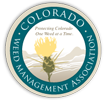
Pine Needle Scale
Damage caused by pine needle scale
The pine needle scale feeds on the needles of most species of pines, spruce, cedar, douglas fir and fir. It causes the most damage to conifers of any insect pest in the Colorado front range.
Pine needle scale insects suck plant fluids from the needles, discoloring the area near the scale, causing needle drop and twig dieback, decreasing overall vigor and increasing susceptibility to other insects and diseases. Large infestations can turn entire trees yellow or gray, and kill branches and young trees.
Low populations of pine needle scale do not usually pose a problem.
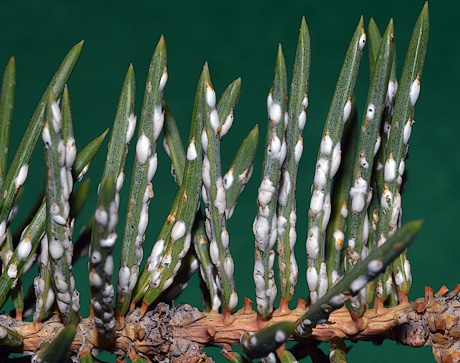 William M. Ciesla, Forest Health Management International, Bugwood.org
William M. Ciesla, Forest Health Management International, Bugwood.org
How to identify pine needle scale
Pine needle scale eggs are tiny and a rosy-purple to crimson-red color.
Newly hatched pine needle scales are called crawlers. They are very small, reddish and resemble tiny aphids.
Nymphs are yellow to golden brown and legless.
Adult female pine needle scale insects are dark orange, wingless, 1/8" long and covered by a white or light yellow oyster-shaped scale. Adult males are about 1/25" long. They have one set of wings and look like tiny wasps
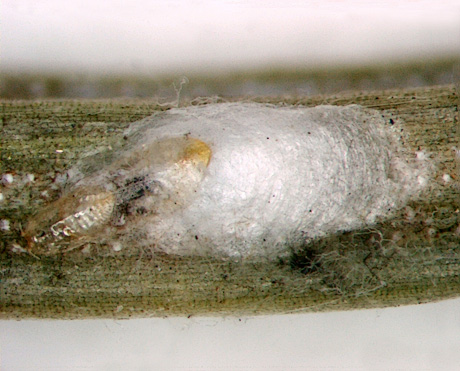 Pennsylvania Department of Conservation and Natural Resources - Forestry Archive, Bugwood.org
Pennsylvania Department of Conservation and Natural Resources - Forestry Archive, Bugwood.org
Life cycle of the pine needle scale
Most pine needle scale insects overwinter in the egg stage beneath the body of the mother scale. Some of the mother scales survive the winter, and can continue laying eggs into the spring.
The eggs start hatching in May or June, but an early hatch, beginning in late April, continuing to mid-June, may occur after a mild winter.
The newly hatched pine scale insects (crawlers) crawl around the needles for a few days before selecting a spot to pierce the needle and start sucking the plant fluids. They turn yellow to golden brown after shedding. Males continue feeding for a few weeks until they become winged adults and fly off to find females in early July. The females remain in one place for the rest of their lives. They will lay 20-30 eggs in the Fall.
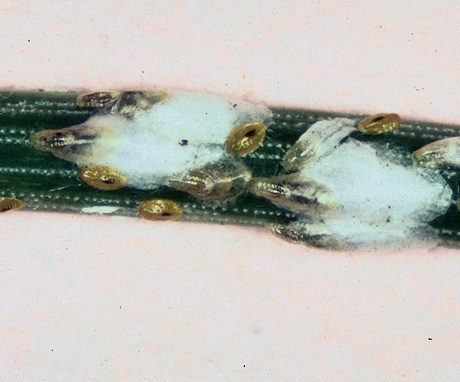 E. Bradford Walker, Vermont Department of Forests, Parks and Recreation, Bugwood.org
E. Bradford Walker, Vermont Department of Forests, Parks and Recreation, Bugwood.org
How to control the pine needle scale
Minimize tree stress, prune to remove infested branches, locating trees in a good location without air pollution and dust will lower their susceptibility to pine needle scale. Lady beetles and wasps prey on pine needle scale insects. Unfortunately, natural predators of pine needle scale insects are not always sufficient controls. Pine needle scale can be controlled with horticultural oils however, oils can discolor spruce trees. Systemic injections can provide excellent control, but may require several treatments over several years to restore tree health in extreme infestations.
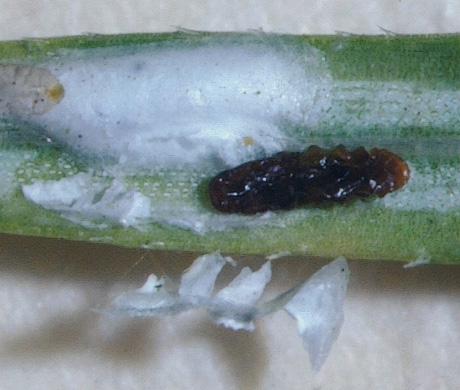 Pennsylvania Department of Conservation and Natural Resources - Forestry Archive, Bugwood.org
Pennsylvania Department of Conservation and Natural Resources - Forestry Archive, Bugwood.org
Other resources




